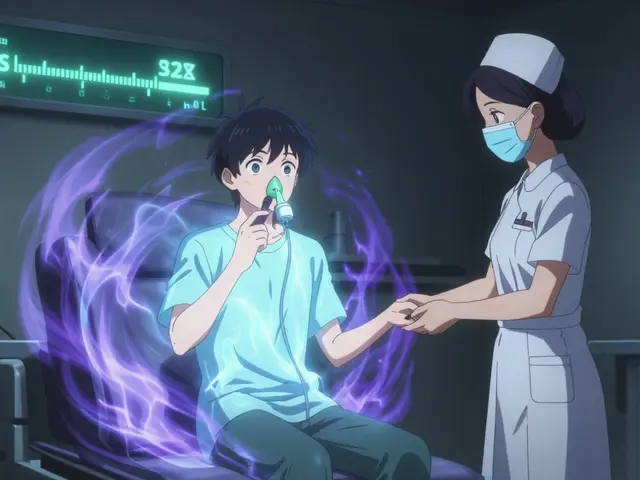Understanding Brinzolamide Eye Drops
As someone who cares about their eye health, it's important to stay informed about the safety and effectiveness of various eye drop options. In this article, we're going to take a closer look at brinzolamide eye drops, a popular choice for managing eye conditions such as glaucoma. We'll explore how these eye drops work, their benefits, potential side effects, and much more. So, let's dive in and learn more about this important eye care product.
How Brinzolamide Eye Drops Work
Brinzolamide eye drops are classified as a carbonic anhydrase inhibitor. This means that they work by reducing the production of fluid in the eye, which in turn lowers the pressure inside the eye. High intraocular pressure can cause damage to the optic nerve and lead to vision loss, so maintaining a healthy eye pressure is crucial for preventing conditions like glaucoma. By using brinzolamide eye drops, you can effectively manage your eye pressure and protect your vision.
Benefits of Brinzolamide Eye Drops
There are several benefits to using brinzolamide eye drops as part of your eye care routine. First and foremost, these eye drops are proven to be effective in reducing intraocular pressure, which can help prevent or manage glaucoma. Additionally, brinzolamide eye drops have fewer systemic side effects compared to oral carbonic anhydrase inhibitors, making them a safer choice for many patients. They are also easy to use and can often be combined with other eye drop medications for a more comprehensive approach to eye care.
Potential Side Effects of Brinzolamide Eye Drops
As with any medication, it's important to be aware of potential side effects associated with brinzolamide eye drops. Some common side effects may include burning or stinging upon application, blurred vision, dry eyes, or an unpleasant taste in the mouth. Less common but potentially more serious side effects can include eye pain, swelling, or redness, as well as signs of an allergic reaction such as rash, itching, or swelling of the face, tongue, or throat. If you experience any of these more serious side effects, it's important to contact your healthcare provider right away.
Proper Use and Storage of Brinzolamide Eye Drops
To ensure the safety and effectiveness of brinzolamide eye drops, it's important to follow proper usage and storage guidelines. Always wash your hands before applying eye drops, and avoid touching the dropper tip to any surfaces, including your eye, to prevent contamination. Follow your healthcare provider's instructions for the correct dosage and application frequency, and be sure to report any ongoing issues or concerns. Store your eye drops in a cool, dry place away from direct sunlight, and always check the expiration date before use.
Interactions with Other Medications
Before starting any new medication, it's important to discuss potential interactions with your healthcare provider. Brinzolamide eye drops may interact with other medications, including other eye drops or oral carbonic anhydrase inhibitors. Additionally, certain medical conditions may affect the safety and effectiveness of brinzolamide eye drops, so be sure to provide your healthcare provider with a complete medical history to ensure the best possible care.
Consulting Your Healthcare Provider
Ultimately, the decision to use brinzolamide eye drops should be made in consultation with your healthcare provider. They can help determine if these eye drops are the right choice for you based on your specific needs, medical history, and any potential risks. By working closely with your healthcare provider, you can ensure that you're taking the best possible care of your eyes and preserving your precious vision for years to come.








Having personally tried brinzolamide drops, I can confirm they do reduce intra‑ocular pressure effectively, provided the dosing schedule is followed meticulously. The carbonic anhydrase inhibition mechanism is well‑documented, and the formulation minimizes systemic absorption, which is a notable advantage over oral agents. Users often report a mild stinging sensation upon instillation, but this side effect typically subsides after a few applications. It is essential to avoid contaminating the tip, as this can introduce pathogens into the ocular surface. Moreover, storing the bottle in a cool, dry place preserves the drug’s stability throughout its shelf life. If any persistent irritation occurs, consulting an ophthalmologist promptly is advisable.
Wow, this article makes brinzolamide sound like a superhero for our eyes!!! I love that it’s easy to combine with other drops, and the fact that it has fewer systemic side effects is just amazing!!! Remember to shake the bottle gently before each use and keep those eyes sparkling and healthy!!!
Sure, because dropping chemicals in your eye is always a great idea
Oh dear, the moment I heard about the burning sting, I felt my heart race like a drum in a storm! But fear not, brave vision warriors, for perseverance conquers the tiny flare of discomfort, and soon your sight shall glow brighter than sunrise.
They don’t tell you that big pharma pushes brinzolamide to keep you dependent on endless prescriptions, a silent control over your vision while they profit in the shadows. Every drop is a reminder that your health is a market, and the real cure is awareness not chemicals.
From a pharmacodynamic standpoint, brinzolamide operates as a selective carbonic anhydrase II inhibitor, attenuating aqueous humor production via reversible enzyme binding, which translates clinically into a measurable decrease in millimeters of mercury intra‑ocular pressure. The therapeutic window is sufficiently broad to accommodate inter‑patient variability, yet clinicians must remain vigilant for idiosyncratic hypersensitivity reactions that may manifest as ocular surface inflammation. Empirical evidence from randomized, double‑blind trials indicates a mean reduction of 3–4 mm Hg after four weeks of monotherapy, comparable to timolol yet with a more favorable systemic profile. However, the marginally delayed onset of action necessitates patient education to mitigate premature discontinuation. Adjunctive therapy with prostaglandin analogues often yields synergistic benefits, underscoring the importance of a multimodal regimen tailored to the individual’s risk stratification. In terms of pharmacokinetics, the ocular absorption exhibits a biphasic pattern, with an initial rapid phase followed by a sustained release governed by corneal permeability coefficients. The metabolite, N‑acetyl‑brinzolamide, is excreted predominantly via renal pathways, demanding dose adjustments in patients with compromised glomerular filtration rates. Moreover, the ocular surface tolerability profile is generally acceptable, with transient burning sensations reported in less than 15 % of subjects, aligning with the known class effect of topical carbonic anhydrase inhibitors. It is prudent to counsel patients on proper instillation techniques-avoidance of contact between the dropper tip and the conjunctival sac-to preserve sterility and prevent iatrogenic infections. Storage considerations are equally critical; exposure to temperatures exceeding 30 °C may accelerate degradation of the active moiety, potentiating variability in therapeutic efficacy. Lastly, the psychosocial dimension of chronic glaucoma management cannot be overlooked; adherence is often contingent upon patient perception of benefit versus inconvenience, a balance that can be enhanced through shared decision‑making and transparent risk‑benefit discussions. In summary, brinzolamide presents a robust option within the armamentarium against ocular hypertension, provided that clinicians remain cognizant of its pharmacologic nuances and integrate patient‑centered care strategies throughout the treatment continuum.
While your exposition is thorough, the reality is that many patients simply cannot afford the luxury of such nuanced regimens; cheap alternatives exist and should be considered without the academic fluff.
Absolutely, the depth you provided helps demystify the science for those of us trying to stay motivated on our eye health journey. It’s encouraging to see how each piece fits into a bigger picture, and your emphasis on patient education resonates deeply. Let’s keep sharing these insights so the community feels empowered and supported every step of the way!
The article offers a competent overview of brinzolamide.
Yeah, it’s solid info but adding a lil’ personal story about how it saved my grandma’s sight would make it pop even more!